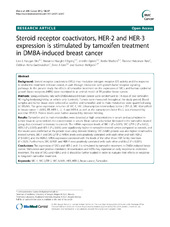| dc.contributor.author | Moi, Line Leonora Haugan | en_US |
| dc.contributor.author | Flågeng, Marianne Hauglid | en_US |
| dc.contributor.author | Gjerde, Jennifer | en_US |
| dc.contributor.author | Madsen, Andre | en_US |
| dc.contributor.author | Røst, Therese Halvorsen | en_US |
| dc.contributor.author | Gudbrandsen, Oddrun Anita | en_US |
| dc.contributor.author | Lien, Ernst Asbjørn | en_US |
| dc.contributor.author | Mellgren, Gunnar | en_US |
| dc.date.accessioned | 2014-11-06T14:17:51Z | |
| dc.date.available | 2014-11-06T14:17:51Z | |
| dc.date.issued | 2012-06-15 | eng |
| dc.identifier.issn | 1471-2407 | |
| dc.identifier.uri | https://hdl.handle.net/1956/8718 | |
| dc.description.abstract | Background: Steroid receptor coactivators (SRCs) may modulate estrogen receptor (ER) activity and the response to endocrine treatment in breast cancer, in part through interaction with growth factor receptor signaling pathways. In the present study the effects of tamoxifen treatment on the expression of SRCs and human epidermal growth factor receptors (HERs) were examined in an animal model of ER positive breast cancer. Methods: Sprague-Dawley rats with DMBA-induced breast cancer were randomized to 14 days of oral tamoxifen 40 mg/kg bodyweight/day or vehicle only (controls). Tumors were measured throughout the study period. Blood samples and tumor tissue were collected at sacrifice and tamoxifen and its main metabolites were quantified using LC-MS/MS. The gene expression in tumor of SRC-1, SRC-2/transcription intermediary factor-2 (TIF-2), SRC-3/amplified in breast cancer 1 (AIB1), ER, HER-1, -2, -3 and HER-4, as well as the transcription factor Ets-2, was measured by real-time RT-PCR. Protein levels were further assessed by Western blotting. Results: Tamoxifen and its main metabolites were detected at high concentrations in serum and accumulated in tumor tissue in up to tenfolds the concentration in serum. Mean tumor volume/rat decreased in the tamoxifen treated group, but continued to increase in controls. The mRNA expression levels of SRC-1 (P=0.035), SRC-2/TIF-2 (P=0.002), HER-2 (P = 0.035) and HER-3 (P = 0.006) were significantly higher in tamoxifen treated tumors compared to controls, and the results were confirmed at the protein level using Western blotting. SRC-3/AIB1 protein was also higher in tamoxifen treated tumors. SRC-1 and SRC-2/TIF-2 mRNA levels were positively correlated with each other and with HER-2 (P≤0.001), and the HER-2 mRNA expression correlated with the levels of the other three HER family members (P<0.05). Furthermore, SRC-3/AIB1 and HER-4 were positively correlated with each other and Ets-2 (P<0.001). Conclusions: The expression of SRCs and HER-2 and -3 is stimulated by tamoxifen treatment in DMBA-induced breast cancer. Stimulation and positive correlation of coactivators and HERs may represent an early response to endocrine treatment. The role of SRCs and HER-2 and -3 should be further studied in order to evaluate their effects on response to long-term tamoxifen treatment. | en_US |
| dc.language.iso | eng | eng |
| dc.publisher | BioMed Central | eng |
| dc.rights | Attribution CC BY | eng |
| dc.rights.uri | http://creativecommons.org/licenses/by/2.0 | eng |
| dc.subject | SRC-1 | eng |
| dc.subject | SRC-2/TIF-2 | eng |
| dc.subject | SRC-3/AIB1 | eng |
| dc.subject | HER | eng |
| dc.subject | HER-2 | eng |
| dc.subject | Breast cancer | eng |
| dc.subject | Tamoxifen | eng |
| dc.title | Steroid receptor coactivators, HER-2 and HER-3 expression is stimulated by tamoxifen treatment in DMBA-induced breast cancer | en_US |
| dc.type | Peer reviewed | |
| dc.type | Journal article | |
| dc.date.updated | 2013-08-23T09:16:34Z | |
| dc.description.version | publishedVersion | en_US |
| dc.rights.holder | Copyright 2012 Haugan Moi et al.; licensee BioMed Central Ltd | |
| dc.rights.holder | Line L Moi et al.; licensee BioMed Central Ltd. | |
| dc.source.articlenumber | 247 | |
| dc.identifier.doi | https://doi.org/10.1186/1471-2407-12-247 | |
| dc.identifier.cristin | 959475 | |
| dc.source.journal | BMC Cancer | |
| dc.source.40 | 12 | |

